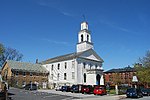New Bedford (Massachusett: Accushnet) is a city in Bristol County, Massachusetts, United States. It is located on the Acushnet River in what is known as the South Coast region. Up through the 17th century, the area was the territory of the Wampanoag Native American people. English colonists bought the land on which New Bedford would later be built from the Wampanoag in 1652, and the original colonial settlement that would later become the city was founded by English Quakers in the late 17th century. The town of New Bedford itself was officially incorporated in 1787.
During the first half of the 19th century, New Bedford was one of the world's most important whaling ports. At its economic height during this period, New Bedford was the wealthiest city in North America per capita. New Bedford was also a center of abolitionism at this time. The city attracted many freed or escaped African-American slaves, including Frederick Douglass, who lived there from 1838 until 1841. The city also served as a setting in Herman Melville's 1851 novel Moby-Dick. From 1876 to 1900, New Bedford served as the initial home port for the Revenue Cutter School of Instruction, the precursor of the United States Coast Guard Academy.At the 2020 U.S. census, New Bedford had a population of 101,079, making it the state's ninth-largest city and the largest of the South Coast region. The city is also known for its high concentration of Portuguese Americans. New Bedford remains known for its fishing fleet and accompanying seafood industry, which as of 2019 generated the highest annual value of any fishing port in the United States. The city is also home to the New Bedford Whaling Museum and New Bedford Whaling National Historical Park.







